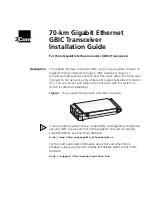
Mounting Location
• The process temperature and ambient temperature must be within the specified
limits.
• The probe must be located away from tank inlets or chutes where material may fall
on the probe during filling or emptying.
• Avoid placing the probe close to agitators or other such devices.
• When used with high density bulk material, the probe must be protected from
material shifts that would bend or shift the probe.
• If a cable probe is used, make sure that shifting bulk material will not exert too much
strain on the cable connections.
The accuracy of the CRF2 is very dependent on the installation of the probe. The probe
must be installed vertically and parallel to the reference ground, particularly for non-
conductive materials. The reference ground may be a conductive tank wall or other
internal parallel metallic structure. If these are unavailable then a reference electrode
must be installed with the probe (See Figure 1). Support for the probe and reference
electrode must be provided to ensure these components maintain their parallelism.
In nonmetallic tanks a ground reference must be provided. If the probe is near the
wall of the tank an adhesive backed metallic sheet may be applied to the outside tank
wall nearest to the probe. Other metallic objects may be used also if they are in close
proximity to the tank wall. If the probe is located further than 6 inches from the wall,
an internal conductor must be provided parallel to and within 6 inches of the probe.
Maintain a minimum of 1 inch spacing between the probe and the reference conductor.
These conductors must be connected to the case ground of the sensor. An internal
ground clamp is provided for this if other grounding is not available.
If turbulence or material movement within the tank could cause probe movement, the
probe must be supported appropriately with non-conductive material to minimize this
movement (See Figure 2).
When installing a unit that has a Remote Mount Housing, the probe should be
installed before the coaxial cable is connected. This will prevent twisting of the cable
and possible damage to the unit. The housing can be mounted in any position using
the bracket provided, being careful to prevent kinking or pulling the cable. The cable
should be connected to probe by inserting the cable through the cable gland on the
probe’s conduit enclosure and pushing the quick connect onto the spade terminal
provided. Be sure to replace the enclosure cover and tighten the cable gland to protect
and seal the connections.
Electrical Connection (See Figure 3)
NOTE:
Installation must be made in accordance with local codes and regulations.
When fishing wire through the conduit connection do not allow the wire to touch or
press on components on the boards. Damage to the circuitry may result. Make sure
that the wire is routed so it will not interfere with the calibration switches.
The CRF2 provides a 1/2˝ NPT female port for conduit connection. The conduit
connection must be made such that condensation is not allowed to enter the sensor
housing. If necessary install a conduit breather drain in a separate conduit body to
prevent buildup of moisture. If nonmetallic conduit is used the protective ground may
be connected to the internal ground connection screw.
The CRF2 transmitter is designed as a two wire 4 to 20 mA device. Connection to
the board is through a two pin terminal block. The circuitry is non-polarized so the
positive and negative leads may be connected to either pin. It is recommended that
shielded twisted pair wire be used if the potential exists for interference from external
noise sources. Ground the shield at the case using the internal ground screw and
leave the other end of the shield open. Do not use the shield as one of the current
loop conductors.
The body of the CRF2 must be grounded to the tank or other earth ground using
the internal ground screw provided. If the tank is non-conductive then a reference
electrode must be provided. This reference electrode must be connected to the case
ground.
Power Supply
The transmitter requires a minimum of 10 Volts DC at its connection for proper operation,
and a maximum of 35 Volts. Choose a power supply with a voltage and current rating
sufficient to meet this power specification under all operational conditions. If the supply
is unregulated, make sure that the output voltage remains within the required voltage
range under all power line conditions. Ripple on the supply should not exceed 100 mV.
Loop Resistance
The maximum allowable loop resistance is dependent on the power supply voltage.
The maximum loop voltage drop must not reduce the transmitter voltage below the 10
Volt minimum. The maximum loop resistance can be calculated using the following
equation:
R
max
=
Where V
ps
is the power supply voltage.
V
ps
- 10.0
20 mA
Do not exceed the specified supply voltage rating. Permanent
damage not covered by the warranty may result. This unit is not
designed for AC voltage operation .
CAUTION
SUPPORTS
6
(152.40)
MAX
1
(25.40)
MIN
7-1/16
(179.39)
DEAD AREA
“L”
Figure 1: Attached Ground
Rod Option
Figure 2: Supports to
Tank Side Wall






















